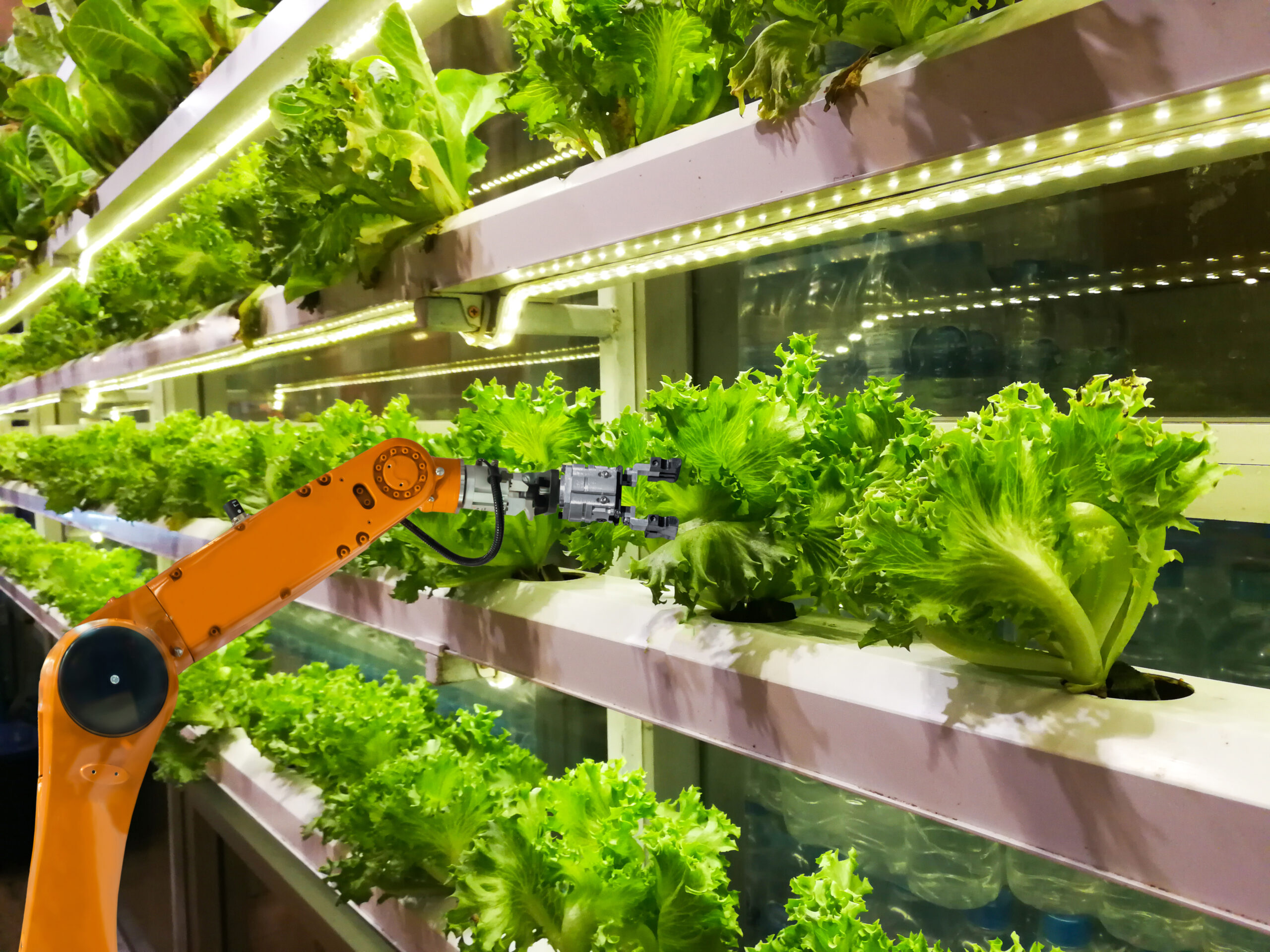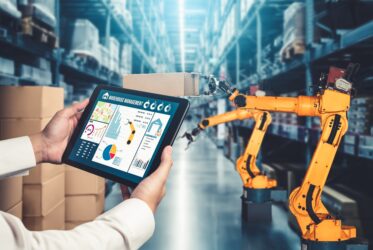
The food and beverage industry is known for tight margins and stiff competition. To compete, succeed, and then maintain that success in this $6,383.49 billion industry, all business components need to work together seamlessly.
From skilled labor, specialized equipment, quality control, and compliance to branding and effective management practices, there are countless challenges in operating a food business. Varying demands and seasonal fluctuations further complicate production.
Technology continues to significantly affect food and beverage manufacturing and supply chain solutions. With higher demand for sustainable products and improved food safety standards, technology offers supply chain solutions to increase efficiency while reducing emissions, packaging, energy use, and waste. Tech-driven operations use automated systems for improved quality control, demand forecasting, maintenance, production scheduling, and supply chain tracking.
Automation, robotics, blockchain, and IoT (Internet of Things) are four technologies that have a tremendous impact on food and beverage industry functions. This guide identifies each technology and how it can be implemented to elevate your business.
Automation
Automation involves applying technology to monitor and control an apparatus or process, allowing the automatic delivery of products and services. Automated systems can take care of most of the inconsistencies and human errors that cause problems for food companies.
In the food and beverage industry, traceability is a significant benefit of automation. Raw materials and foods can be traced from the production site to order fulfillment with minimal manual input. This gives operators real-time insight into any point of supply, production, and delivery. It is especially beneficial for companies that handle perishable goods.
The right food processing and automation systems can substantially reduce food contamination risks. Automation detects problems at the source, which prevents more serious issues from arising at a later stage.
With rapid changes in the food industry, automation also changes the way we do business. Instead of training workers on new systems, protocols, and regulations, systems can simply be updated to ensure compliance and the required output.
While this may seem like a highly technical and somewhat daunting endeavor, it doesn’t have to be.
Software like Skynamo offers an easy, user-friendly solution to automate many tasks, including the administrative work of managers, sales reps, and HR departments. This allows them to spend their time focusing on the things technology can’t do.
Unlike robotics, automation doesn’t necessarily mean replacing the worker, but rather enhancing their accuracy, efficiency, and productivity. For example, cashiers no longer have to manually type in each item’s price or calculate a total cost. They simply scan the goods, which are automatically registered and tallied.
Robotics
Robotics, however, often can replace humans in the workplace. Traditional robots have visual and/or audio sensors that allow them to execute complex physical processes with minimal or no human assistance.
In the food and beverage industry, robots have started improving processes in many ways. Robotic arms can improve product assembly, therefore reducing production costs, while machine vision systems lessen quality assurance costs and issues.
Robots are becoming equally beneficial in the restaurant industry, where post-pandemic labor shortages continue to pose problems. Robots are not only automatic, intelligent, and able to work 24/7 without requiring overtime, but they are contactless. Customer-facing robots can minimize human contact – another pandemic-driven consumer need.
Robots that make food and beverages allow companies to save money and human resources, minimize mistakes, and reduce food waste.
Take Sally the salad-making robot for example. She can mix up to eight fresh ingredients to put together a compostable bowl containing a fresh salad, in just 90 seconds. Sally helps fast-food chains broaden their menu with healthy dining options without having to employ more staff. Her consistency helps predict costs.
Cecilia, on the other hand, is an interactive and entertaining bartender. She can serve mixed drinks in under 30 seconds and uses AI and speech recognition to guide customers through the menu. Armed with signature drink recipes and compact in stature, she’s a great hostess to place in hotels, restaurants, and casinos.
Blockchain
In the food and beverage industry, blockchain is highly beneficial in the secure handling of administrative records and bringing transparency to the supply chain system. It aims to improve food safety and reduce food fraud.
As opposed to common databases that structure data in tables, blockchain stores data in blocks. When a block is filled with data, it’s secured and chained to the previous block of data. The data structure and information are irreversible, with each block in the chain assigned a time stamp of exactly when it was added. Blockchains are generally decentralized so no single person or group has control over information. Instead, all users retain collective control.
From farmers and logistics to processors, manufacturers, distributors, certifying agencies, and retailers, the food supply chain includes everyone in each step of the process. Although each participant shares product data stored on their server, it isn’t accessible to the other supply chain participants. This would pose food fraud risks.
Blockchain prevents these risks by providing a secure environment where each supply chain participant has access to the relevant data of other participants. Once entered and verified, data cannot be modified or tampered with.
Walmart has adopted this technology to identify contaminated products by tracking environmental data, especially that of imported meat. Bumble Bee Foods is giving consumers a chance to know where their seafood comes from to increase transparency and prevent mislabeling. When consumers scan a product QR code, they can view information regarding where the tuna was caught, by which community, the catch size, and how it came to be fair trade certified.
Nestle, JD.com, and Dutch supermarket chain Albert Heijn are all major brands also implementing blockchain to improve traceability, transparency, and consumer trust as a whole.
Internet of Things
The Internet of Things (IoT) refers to a network of objects embedded with technologies – such as sensors or software – to connect and exchange data with other devices using the internet. It does not include traditional servers and laptops. Examples of IoT devices are smart TVs, smart speakers, wearable tech, and home security systems.
These interconnected systems are helping companies to achieve the highest level of food safety while reducing losses and improving traceability across food processing and packaging stages.
For example, perishable goods (like meat and dairy) require optimal storage at specific temperatures throughout their producer-to-consumer journey. Using IoT allows temperature monitoring around the clock and can send alerts as soon as temperatures rise above a given threshold. This minimizes loss and prevents major problems down the line. If gathered data from sensors indicates potential food safety violations or issues, it can also trigger staff to verify mandatory food safety inspections.
IoT also enables increased operational efficiency. It facilitates the streamlining of workflows, communication, and real-time operations tracking. It reduces manual processes that risk human error and enhances process implementation for continuous operational and administrative improvement.
Use the right tool to enhance your business
Neglecting the importance of implementing technology in the food and beverage industry will cost companies in the long run. Skynamo offers a simple tech solution for accessing real-time reports and staying ahead of supply chain pitfalls before they cause problems.
With Skynamo’s CRM tool field, sales reps gain access to live product, pricing, and customer information. Automating manual tasks with Skynamo leads to improved efficiency and performance while also giving managers real-time sales insights. Sales teams can use mobile devices to generate quotes, check stock, and issue orders as well as access customer order history to improve the customer experience.
Chat with a Skynamo team member to learn how our CRM tool can change the game for your food and beverage operations today!

